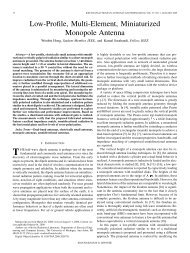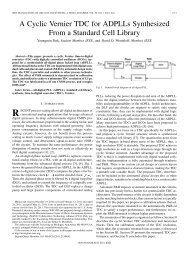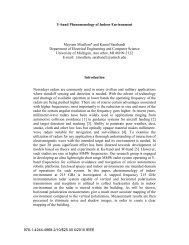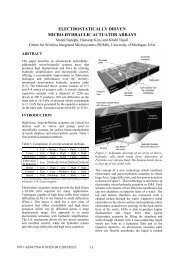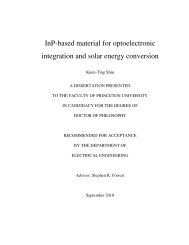A 14 mW Fractional-N PLL Modulator With a Digital ... - IEEE Xplore
A 14 mW Fractional-N PLL Modulator With a Digital ... - IEEE Xplore
A 14 mW Fractional-N PLL Modulator With a Digital ... - IEEE Xplore
Create successful ePaper yourself
Turn your PDF publications into a flip-book with our unique Google optimized e-Paper software.
FERRISS AND FLYNN: A <strong>14</strong> <strong>mW</strong> FRACTIONAL-N <strong>PLL</strong> MODULATOR WITH A DIGITAL PHASE DETECTOR AND FREQUENCY SWITCHING SCHEME 2465<br />
Section II introduces an all-digital phase detector, which relies<br />
on a single flip-flop for phase quantization. Section III introduces<br />
a simple digital dual-modulation scheme that alleviates<br />
the tradeoff between loop bandwidth and switching speed, for<br />
FSK modulation schemes. Section IV discusses additional implementation<br />
details, and finally Section V discusses measured<br />
results and conclusions.<br />
Fig. 2. Using a flip-flop as a phase quantizer.<br />
II. DIGITAL PHASE DETECTOR<br />
An F<strong>PLL</strong> system can be considered to be a type of digital-to-analog<br />
or more specifically a digital-to-frequency<br />
converter, with the phase of the input clock acting as the reference,<br />
the frequency of the input clock corresponding to the<br />
sampling rate, the divider control corresponding to the digital<br />
input, and finally the frequency of the RF signal corresponds<br />
to the output. It should come as no surprise that many of the<br />
challenges associated with building these systems in deep sub<br />
micron (DSM) processes are similar to the challenges associated<br />
with ADC/DAC design. In this work we employ converter<br />
design techniques in order overcome some of these limitations.<br />
A block diagram of a conventional fractional- synthesizer<br />
can be seen in Fig. 1. The information extracted by<br />
the phase detector is inherently analog in nature, since the<br />
phase information is not synchronized to either the reference<br />
clock or the divided down VCO clock, and is not quantized.<br />
Although conventional XOR and tristate phase detectors utilize<br />
digital building blocks, a charge pump and filter are still<br />
required to extract useful phase-difference information. In [11]<br />
a time-to-digital converter (TDC) uses multiple flip-flops and<br />
unit delays (in practice inverters) to quantize the time difference<br />
between the edges of the reference clock and feedback clock.<br />
<strong>With</strong> this approach, resolution and linearity are dependant on<br />
the speed and matching of the unit delay elements, and hence<br />
inherently process dependant.<br />
If a conventional TDC is analogous to a flash ADC, with<br />
the unit delays setting the quantization steps, then the proposed<br />
phase detector is analogous to an oversampling ADC, with oversampling<br />
and a phase integration loop used to improve the performance<br />
of a coarse single-bit phase quantizer. To achieve this<br />
we utilize a unique property of a fractional- <strong>PLL</strong>, that is the<br />
ability to control the frequency of the signal coming from the<br />
programmable divider by changing the divide ratio.<br />
The proposed phase detection technique uses a single flip-flop<br />
as a phase comparator, while an additional negative feedback<br />
loop around the programmable divider keeps the phases of the<br />
two clocks aligned to within a single quantization step. On the<br />
rising edge of the reference clock, the flip-flop samples the divided-down<br />
VCO signal, determining whether the divided clock<br />
is ahead or behind the reference clock. In this way, the flip-flop<br />
effectively acts as a one-bit phase quantizer. In Fig. 2 a single<br />
flip-flop is used to quantize the phase difference, , between<br />
the reference clock and the divided down VCO clock. The quantization<br />
noise of the controlled divider is added to the divided<br />
down VCO clock and this acts as dither for the phase<br />
quantizer. If this dither were absent, and for example if is<br />
positive, then the output of the flip-flip (quantizer) would always<br />
be one, irrespective of the magnitude of phase difference<br />
between the divided down clock and reference clock. In the<br />
Fig. 3. New phase detector configuration with the phase minimization loop<br />
(PML).<br />
presence of the dither, the output of the flip-flop is sometimes<br />
one and sometimes zero. Similar to an oversampled ADC, the<br />
low-pass-filtered output of the flip-flop is proportional to .<br />
An approximately linear relationship is achieved if the phase<br />
difference can be kept small relative to magnitude of dither.<br />
Single bit quantized phase detectors can also be found in<br />
Bang-Bang <strong>PLL</strong>s. In a Bang-Bang <strong>PLL</strong> the output signal typically<br />
goes directly to the phase detector (or through a static divider),<br />
hence the phase of the <strong>PLL</strong> output or <strong>PLL</strong> input signal<br />
must change if the output of the phase quantizer is to change<br />
[10]. Therefore in a Bang-Bang <strong>PLL</strong>, the phase quantizer can<br />
only provide information on the polarity of any phase difference<br />
between the system input and output. In contrast, in this work<br />
the VCO output passes through a controlled programmable<br />
divider before it reaches the phase-detector. This means that by<br />
changing the divide value, the phase quantizer is exercised in<br />
the absence of any change in excess phase of the VCO output.<br />
The also provide dither to the phase quantizer, an important<br />
requirement for any oversampled quantizer.<br />
An additional inner feedback loop, seen in Fig. 3, is introduced<br />
to keep the phase difference between the two clocks<br />
small, i.e., minimizing . For this reason the new loop is<br />
called the phase minimization loop (PML). This phase feedback<br />
scheme might be recognized as being similar in form to<br />
a delta modulator, a commonly used ADC/DAC architecture.<br />
In a delta modulator the forward path consists of a quantizer,<br />
and the feedback path includes an integrator. (In this work the<br />
integration occurs because phase information is fedback to the<br />
frequency control of the divider.) The integrator keeps the phase<br />
difference at the input of the quantizer small. Although the<br />
overall <strong>PLL</strong> keeps the average of at zero, the instantaneous<br />
value of is a function of the bandwidth of the <strong>PLL</strong>, which<br />
cannot be set arbitrarily large. The bandwidth of the inner loop,<br />
however, can be set to be larger than that of the overall <strong>PLL</strong>,<br />
hence can do a better job keeping the two clocks in close phase<br />
alignment. This is necessary in order for the phase detector<br />
to behave in an approximately linear fashion. If the phase



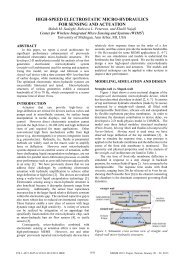
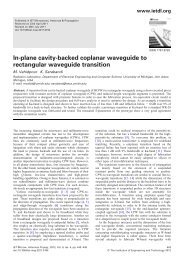
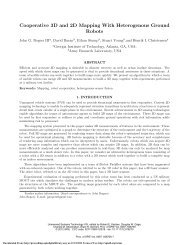
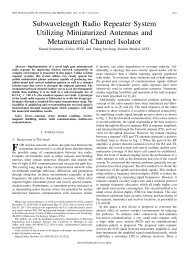
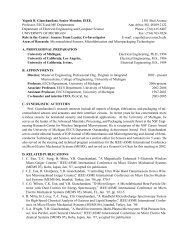
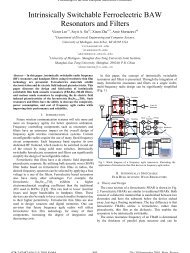
![[Sample B: Approval/Signature Sheet]](https://img.yumpu.com/34084789/1/190x245/sample-b-approval-signature-sheet.jpg?quality=85)

